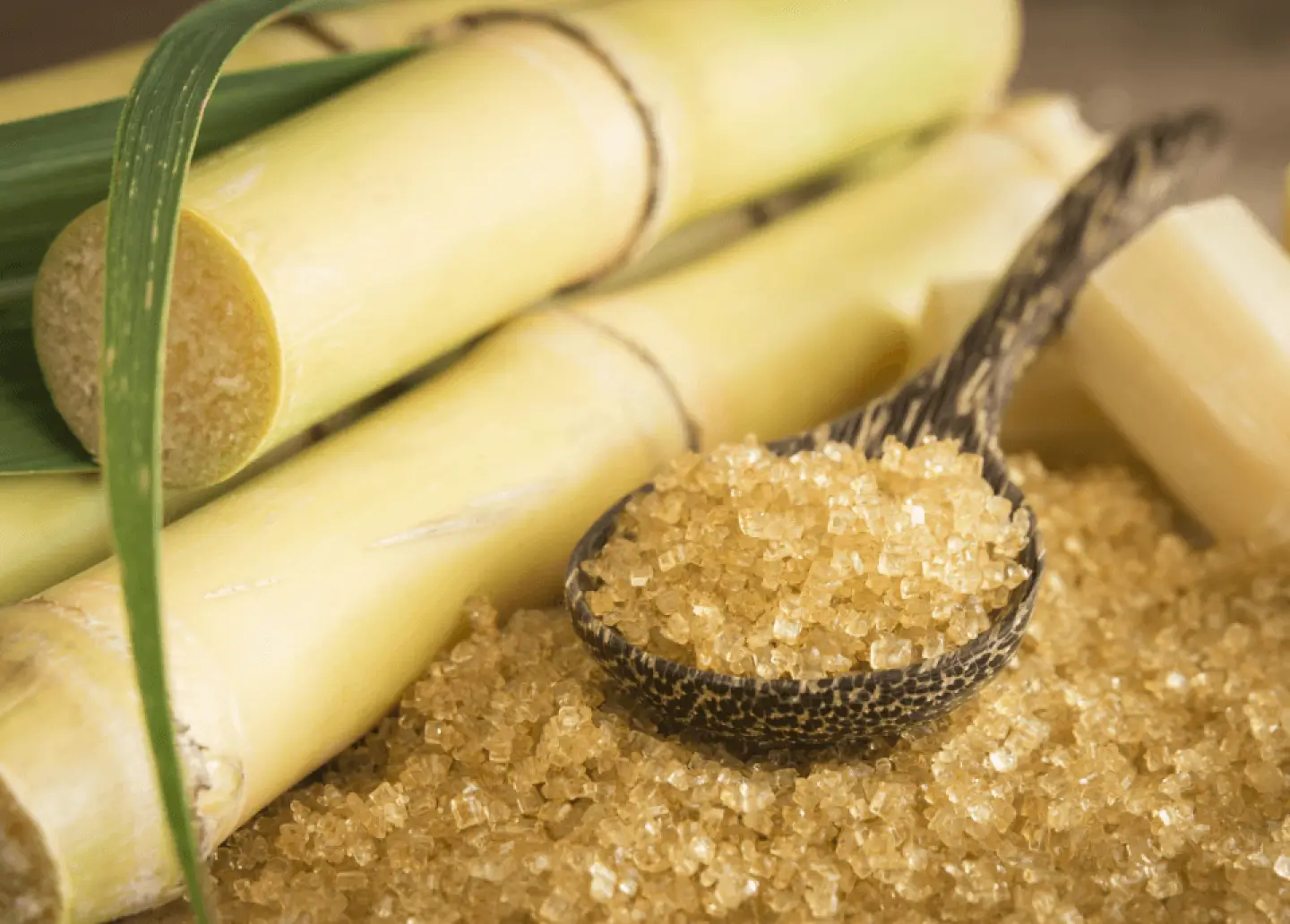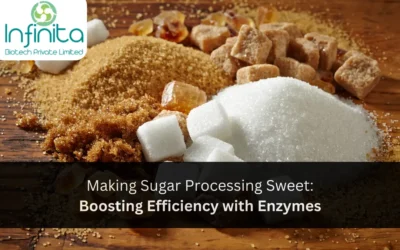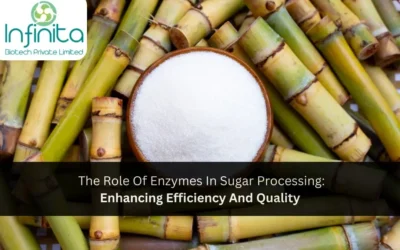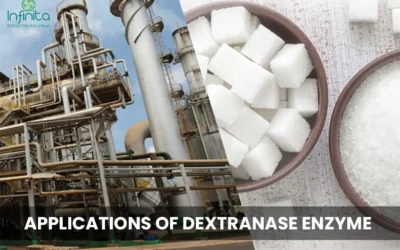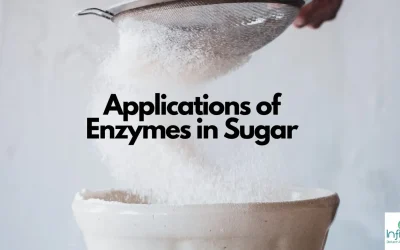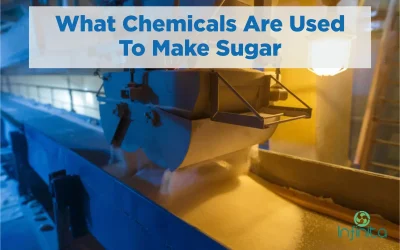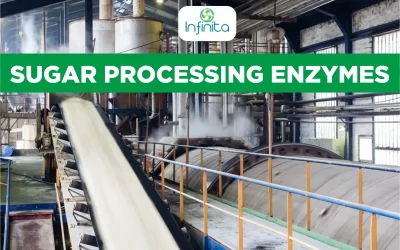What Is Dextranase Enzyme?
Dextran is a collective name assigned to a broad class of homopolysaccharides consisting of D-glucans with contiguous a-1, 6 glycosidic linkages (95 per cent), with minor secondary linkages such as a-1, 2, a-1, 3 and a-1, 4. It is formed by microorganisms such as Leuconostoc mesenteries, Streptococcus sp., Acetobacter capsulatus and Acetobacter viscus. Dextrans are very well soluble in liquids, have low toxicity and are relatively inert. These properties make dextranase enzymes proficient water-soluble carriers for dyes, markers and reactive groups in a wide range of applications.
- They are commonly used in pharmaceutical and biochemical industries. Due to the low molecular weight of Dextranase, it is often used as an alternative to blood plasma.
- They are used for therapeutic applications such as drug distribution and cross-linking for the processing of the Sephadex chromatographic matrix.
- They are also commonly used as anti-and retrograde tracers in neurons. On the other hand, the microbial synthesis of dextrans in degraded cane and beets or other sucrose-containing products is a severe concern in the sugar and food industries. Dextran is also a structural component of dental plaque that triggers the formation of dental caries.
Dextranase Enzymes
Dextranase enzymes attach a-1, 6 glycosidic bonds of dextran to yield either glucose or exodextranases or isomalto-oligosaccharides (endodextranases) and are released as extracellular enzymes by a limited number of bacteria and fungi, including yeasts and probably some complex eukaryotes.
Enzymes in certain groups can be categorised as dextranase by their utility: dextranhydrolases, glucodextranases, exoisomaltohydrolases, exoisomaltotriohydrases, and exo-1, 2-alpha glucosidases.
The chemical reaction catalysed, is as follows:
(1,4-alpha-D-glucosyl)n + (1,4-alpha-D-glucosyl)m + (1,4-alpha-D-glucosyl)n-1 + (1,6-alpha-D-glucosyl)m + 1
These enzymes belong to the family of glycosyltransferases, mainly exosyltransferases. The systematic name of this class of enzyme is as follows:
1, 4-alpha-D-glucan: 1, 6-alpha-glucan 6-alpha-d-glucosyltransferase.
Some broadly used terms are dextrin 6-glucosyltransferase and dextrin dextranase.
Several microorganisms are known to grow dextranase, including filamentous fungi belonging to the genera Penicillium, Aspergillus, Spicaria, Fusarium and Chaetomium, bacteria, e.g. Lactobacillus, Cellvibrio, Flavobacterium and so forth. The only yeasts observed to produce dextranases are members of the Lipomycetaceae family. Only Lipomyces cononenkoae and Lipomyces starkeyi dextranases are identified by far.
Industrial Applications Of Dextranase Enzymes:
Potential industrial applications of dextranases include:
- The synthesis of relatively significant oligosaccharides.
- Potential oral wash ingredients after isomaltose can be of considerable value for the prevention of dental caries,
- Clearance of dextran contaminants in the manufacturing of cane sugar.
The dual-stimulus-responsive drug releases a biodegradable polymer-structured gelatine and dextran hydrogels. Hydrogels are used for a wide variety of uses in biomaterials such as contact lenses, drug delivery vehicles and tissue adhesives.
Dextrans are polymers that imitate organic sugars present on tissue surfaces. The dextran hydrogel device with tunable mechanical and biochemical properties looks promising for cell culture and tissue engineering applications.
Its drug delivery system is ideal for delivery of medications to the colon. Brondsted et al. researched the use of glutaraldehyde dextran as a capsule substance for colon-specific drug delivery. Dextran capsules were treated with a dextranase solution, which replicated the production of the drug to the colon so that it broke and the drug was released as a dosing pump. The finding highlights the dextran capsules as promising candidates for colon-specific drug delivery, even in site-specific drug delivery mechanisms with antibody use.
Dextrans also improve the pressure of brewing yeast for the beer industry. Due to the growing demand for low-calorie drinks, including beer, recombinant strains of Saccharomyces cerevisiae have been developed through the incorporation of Lipomyces Starkey’s LSD1 gene. S. Cerevisiae cannot generate extracellular depolymerizing enzymes that can effectively release fermentable sugar from abundant, polysaccharide-rich substrates. By adding the gene alluded to above, the inclusion of an exogenous enzyme during beer fermentation to achieve starch hydrolysis and the reduction of oligosaccharide can be prevented. Carbohydrate activity produced may also be exploited for toxicity in sensitive chromogenic bioassays: a mycotoxin bioassay using intracellular Î2-galactosidase activity of Kluyveromyces marxianus has been developed.
Uses Of Dextranase Enzymes In Sugar Industry:
The use of dextranases enzymes in the sugar industry was proposed more than two decades ago when the enzyme was only researched in the preparation of therapeutic dextrans used as a supplement for blood plasma and, more recently, in toothpaste formulations to hydrolyze the dextrans found in dental surfaces. Since then, industries have been making preparations for dextranases to be used in the sugar production process.
- The first commercially released dextranase enzymes preparations were DN 25 L and later DN50 L. The enzymatic preparation of Dextranase 50 L proposed that it be used directly to hydrolyze dextrans in juices.
- Over the years, the use of dextranase CAS 9025-70-1 in the sugar industry has grown. In the 1990s, the discovery of the production method in Pichia pastoris of recombinant dextranase P. minioluteum by Cuban researchers culminated in the formulation of the enzymatic preparation Hebertec-Dextranase, which was used for industrial application trials in various sugar mills.
- In the year 2002, a new enzymatic formulation, Dextranase Plus L, came in the market. This enzyme had improved thermal stability characteristics of up to 85 pHC and a broader pH range of between 3 and 7 pH developed from Chaetomium erraticism fungus. Before the formation of this enzyme, Dextranase L was already present on the market and was used in juices and syrups. The enzymatic preparation of Dextranase Plus L determines its particular application for juice or syrup, expanding the probability of use in the presence of higher temperatures due to thermal tolerance.
- P. aculeatum dextranase in juices derived from various parts of the sugar cane harvested under different conditions indicated that the enzyme was particularly useful when the processing process was crucial and the sour cane was supplied. Long reaction times and low Brix were favourable conditions for enzymatic hydrolysis when Dextranase was applied at the initial stage of the process in the mills or during evaporation.
The System That Favours Dextranase Enzymes
Dextranase enzymes behaviour is influenced by temperature, pH, metal ions and nutrients. According to Lin Chen et al (2007), dextranase activity is optimised between 10oC and 60oC at pH of 6.0[12]. In the specific sample, the influence of pH on enzyme activity was calculated by varying the pH between 3.5 and 8.5 at a temperature of 30oC. The pH values of 3.4-4.5, 5.0-7.5 and 8.0-8.5 were retained by the sodium acetate buffer (20mM), the citrate and phosphate buffer (20mM) and the sodium phosphate buffer (20mM) respectively. The effects of metal ions (AlCl3, CaCl2, CoCl2, CuSO4, FeCl3, KCl, MgCl2, NaCl, NiSO4, MnCl2 and ZnCl2) and SDS on dextranase activity were tested by incubation of dextranase with 1 mM metal ions or 1 mM SDS at pH 4.5 at 37oC at 3h, and the enzyme activity of dextranase was then calculated.
Ravi Kiran Purama and Arun Goyal (2008) estimated dextransucrase behaviour in a cell-free extract of Leuconostoc mesenteries in a study to optimise nutritional factors. The regression coefficients and t-values of six substances were analysed: yeast extract, sucrose, intercept, K2HPO4, beef extract, peptone and Tween 80. Yeast extract, sucrose, beef extract and K2HPO4 had a positive impact on enzyme development, while peptone and Tween 80 harmed enzyme production. The variables with confidence levels greater than 90% are deemed to be significant. Sucrose was important at 99.99 per cent confidence in dextransucrase output. K2HPO4 and yeast extract were found to be important at around 94 per cent in the development of dextransucrase. The beef extract was important at 91 per cent for the production of dextransucrase. Peptone and Tween 80 were determined to be negligible with negative enzyme activity coefficients.
